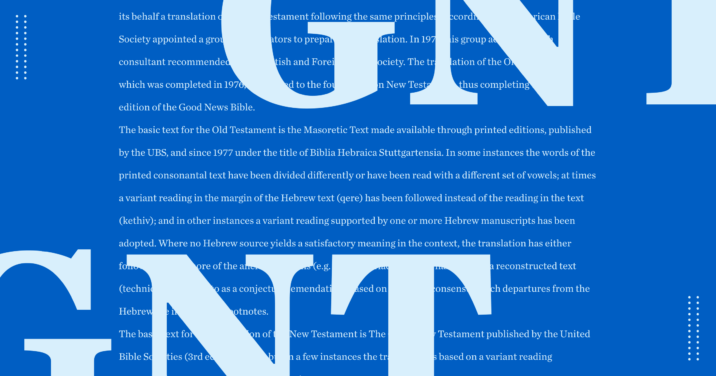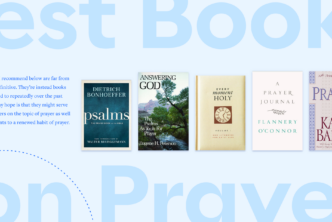There are many, many options for reading and studying the Greek New Testament. There are more studies, editions, and tools available to the student or scholar than ever before. Manuscripts are available at a click. Surveys of historical opinion are accessible with a simple search.
But this presents a problem. Options require choice. Choice can become paralyzing. Short of flipping a coin, how can a pastor or student select the best Greek New Testament for them from the numerous significant editions available?
Options
One option is to have the choice made for you: simply use whichever edition of the Greek New Testament your Greek professors assigns. Another is to follow the advice of Mark Ward elsewhere on this blog and primarily rely on the SBLGNT. It’s free, it’s available online, and it provides a survey of textual variants in other major editions. (I worked closely with SBLGNT editor Mike Holmes, observing first-hand his meticulous attention to detail.)
In this post, however, I’m going to propose a different option: choose not to choose. Or to put it another way, use all of the available modern editions, but each for its own purpose.
Which editions am I talking about?
In the following discussion, I’ll focus on the three most common and accessible GNTs currently available:
- NA28/UBS5
- SBLGNT
- THGNT
If that alphabet soup already chills you, don’t worry, all will be made clear soon.1
1. The NA28/UBS5
The Nestle-Aland, Novum Testamentum Graece (28th ed.) and the United Bible Society, Greek New Testament (5th ed.)—NA28 and UBS5, respectively—are, for most purposes, the same. The NA28 is aimed at scholars, and it therefore presents a fuller textual apparatus, while the UBS5 is aimed at pastors and students. It provides a smaller apparatus along with (dubiously helpful) letter grades indicating the editors’ confidence regarding individual textual decisions. The NA28 is generally viewed as the standard scholarly edition of the Greek New Testament. If a New Testament scholar who is not a textual critic is interpreting some passage or other, it is likely that the NA28 is in front of him or her.
Nestle-Aland editions up through the twenty-seventh edition used standard “reasoned eclecticism”2 and were edited by some of the leading textual critics of their various days. With the twenty-eighth edition, in the Catholic Epistles, the editors have added a new consideration, the coherence-based genealogical method (CBGM), a technology-assisted method that informs the editors’ decisions. The details of that tool are far beyond the scope of this article,3 but it should suffice to say it is new and different enough from previous methods to mark a genuine departure from previously prevailing practices.
2. The SBLGNT
The Society of Biblical Literature Greek New Testament, produced in concert with the Logos Bible Study Platform, was edited by Michael W. Holmes with reference to four previous editions:
- Westcott and Hort’s 1881 edition (which was taken as the starting point),
- Samuel Tregelles’ 1857–1879 edition,
- The Greek textual basis of the NIV Bible (which is the NA27 with 231 divergences)
- Robinson and Pierpont’s 2005 edition of the Byzantine text-form
While the text itself is a textbook example of reasoned eclecticism in the mainstream of New Testament textual criticism, the apparatus is somewhat of a divergence. The SBLGNT’s apparatus simply states which editions (not only the four listed as primary, but some others as well) support which readings, and notes occasionally when Holmes supported a reading that none of the four primary editions chose.
3. The THGNT
The Greek New Testament, produced at Tyndale House, Cambridge, is the newest of the editions considered here. Now, I may have some biases here. I was at Tyndale House in the years leading up to the publication of the THGNT, I contributed to a new annotated edition of the THGNT, and I now work closely with Dirk Jongkind on a project related to the THGNT. This edition represents a departure from many modern printing conventions. In a companion volume,4 one of the editors, Dirk Jongkind, sets out the basic methods and distinctives of the THGNT. The editors purposefully limited their manuscript base, leaving the vast majority of what are generally considered later, Byzantine-text manuscripts out of the apparatus. They gave special weight to knowledge of individual manuscripts and the habits of the scribes of particular manuscripts (“scribal habits”), and they worked to represent the textual traditions of the first five centuries.
Why use all three?
Now that we know the three main options, we can talk about why you should use all of them. And you should use all of them. For the sake of brevity, I will spend less time listing the virtues of the SBLGNT—not because they are not there, but because those praises have already been sufficiently sung here on Word by Word. I’ll assume you either already use the SBLGNT and rely on its apparatus to give you a survey of scholarly opinion, or you indiscriminately use some other GNT and don’t much look at the apparatus at all.
1. Details are sometimes pastorally necessary
While it is certainly useful to have a record of what groups of highly trained scholars have decided, there will still be times when it is helpful to see the evidence that they used. I’m not arguing that you should throw yourself into the depths of textual criticism, or that your opinions should be given the same weight as that of the experts in this complex and difficult field. But sometimes, a knowledge of the evidence used by those scholars to make their claims can be beneficial, even necessary.
I say this because the internet exists. If you serve at a church, there will be members of your congregation who will read things (or more likely, see a TikTok) about the Bible from the latest conspiracy theorist or bad-faith controversialist. For these congregants, it will not be enough to be able to say the NIV translators—or Tregelles, or Westcott and Hort—chose a particular reading. The internet may have told them that it was these people in particular who were trying to hide the truth! If, however, you can refer them to specific manuscripts, you may be able to calm and steady distressed sheep.
For example, if a congregant hears that a certain Bible passage is the result of a millennia-long game of telephone and has been hopelessly garbled compared to how the early Christians would have known it, it will do little good to talk about the text reflected in the NIV. It could, however, do much good to point to a third- or fourth-century manuscript that reads the same way. Or if he or she has been told that modern versions intentionally cut out a verse, it can be helpful to show ancient manuscripts which never had it in the first place. For this, you will need a fuller apparatus. You will need something like the NA28 or the THGNT. And to be able to use this to serve the sheep, you need to read this edition enough to know how to use it.
(Of these two options, it is worth noting, that in general the NA28 refers to more manuscripts, while the THGNT gives more detail about the manuscripts it cites, particularly when there are variations in spelling or where the manuscript reading is not entirely certain, so-called videtur readings.)
2. Christians have a footnote-created crisis
When someone who grew up with the story of the woman caught in adultery or the longer ending of Mark finds a note in their new Bible that says, “Some early manuscripts omit the following,” he or she may rightly wonder what is going on. Again, having an apparatus with more information will help your parishioner more than simply stating that Robinson and Pierpont print these texts whereas the others mark them off as not original. That is the same as saying that the KJV prints these texts and the ESV marks them as not original—which your parishioner likely already knows. More detail, not less, will help you navigate these sticky situations. You will need to be able to walk them through the manuscripts in which these passages do and do not occur (or occur in different forms or in different places). You will need another GNT.5
3. Divergence and convergence in the Greek New Testament both need to be visible
While the previous two points depended on details in the apparatuses of the three editions, this and the next point will be more impressionistic benefits of reading multiple editions with all their various differences in the text itself.
Often, the flood of information about variants in the text of the New Testament can create the impression of a wildly fluid text in which very little is certain. Sometimes, both scholars and YouTubers compound this distress by playing up the number and significance of variants. (As an aside, the best antidote to this manner of thinking is learning New Testament textual criticism deeply.) However, if you form a habit of reading in various GNTs, you will find the opposite. Yes, there are variants. Yes, there are differences, but the overall impression is not only of reading the same general stories and arguments, but the same texts. Do not miss how significant this is. If you read the SBLGNT, the NA28, and the THGNT, you will find substantially the same text despite reading the work of different editors with different base-texts, considering different though overlapping pools of manuscript evidence with different methodologies. It is as if the editorial environment were designed to allow significant difference, and yet produced texts with significant similarity, if not identity.
This is not to say the differences are not real, or that they are never significant. But it is to say the similarities are at least as real and more significant.
4. Readers of the past faced minor textual variation
Reading regularly in different Greek New Testaments brings you closer to the experience of literate Christians of the past. In our own post-printing press age (and doubly so in our post-digital printing age), we are unduly bothered by the presence of variants. We assume uniformity and are bothered by any variation from perfect replication. This is, however, simply a byproduct of our technological moment. For the vast majority of the church’s history, it has been the opposite.
Every manuscript—that is, anything copied by hand—will contain variations and mistakes. This was so obvious and so much a part of common sense that Augustine included a brief discussion on comparing Latin readings with each other and with Greek manuscripts in his work on interpreting Scripture. If we form the habit of reading in various editions, we will both come to share some of the sensibilities and intuitions of earlier readers of Scripture and we will inoculate ourselves against the modern fear of variants.
For this and other reasons, in my intermediate Greek classes, I assign a GNT, but I do not specify which one. Inevitably, this leads to discussions whenever one student reads a verse or passage that is in any way different from what another student is reading.
A concluding scholarly aside
A note for the more academically minded reader: Why should you bother to make recourse to multiple editions?
Again, each has its own benefit.
- The SBLGNT provides two key helps to scholars. First, it is the quickest way to get a survey of various previous editions at key variation units. Sometimes, this really is all you really need to know. Second, in the text, and in the sporadic “Holmes” notes, it provides Mike Holmes’ own judgment, which is a valuable and current contribution.
- The NA28, in the Catholic Epistles, provides a test case for the application of the CBGM. While this tool is still relatively new, it does represent a serious future path for New Testament Textual Criticism. Perhaps surprisingly, there are times when readings using this tool side more with the Byzantine Text than previous editions of the NA. It is likely that it will continue to produce unexpected or even less-than-intuitive results.
- The THGNT, on the other hand, brings the reader closer to the textual tradition of the first five centuries. This is true in the choices of variants as well as in the punctuation, spelling, paragraphing, and ordering of books. Careful attention to the THGNT will bring the reader more information about the manuscripts themselves than any other current edition. While there is no substitute for reading the manuscripts themselves, the THGNT provides a good summary and entry point.
As the NA and THGNT go on to further editions, their editorial methods and texts will diverge even more significantly. A comparison of each subsequent edition will provide the scholar not only with information about the text, but also enlightening information about the ways in which the various editorial methods produce diverging and converging texts and apparatuses.
Related articles
- How to Use Greek Lexicons
- Was the New Testament Written in Hebrew, Aramaic, or Greek?
- 3 Reasons Not to Mention Greek and Hebrew Words in a Sermon

- There’s something even bigger and more comprehensive than any of these: the Editio Critica Maior (ECM), but it’s not complete and is both expensive and hard to navigate, so we’ll put it aside for now. I’ll also not talk about Byzantine Priority editions, like the Robinson-Pierpont, but you can find out more about them here, here, and here.
- Reasoned eclecticism is the method of textual criticism used by almost all NT text critics today. In it, for every variant, external evidence (things like the age of the manuscript and where it is from) and internal evidence (things like the likelihood of the author writing a certain word, or a scribe making a certain mistake) are carefully weighed to determine which reading is more likely to have led to the others. This is opposed to, on one side, thoroughgoing eclecticism, which only considers internal evidence, and on the other side, preferences for certain manuscripts or textual families.
- Peter Gurry and Tommy Wasserman explain the CBGM in much greater detail in their book, A New Approach to Textual Criticism: An Introduction to the Coherence-Based Genealogical Method, and Gurry writes a fuller description in an Evangelical Textual Criticism blog post.
- Reviewed at Word by Word here.
- You may also need to walk them through the history of transmission and translation, but that’s for a different article.






